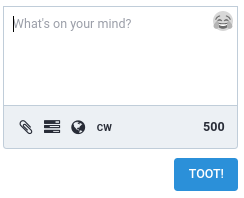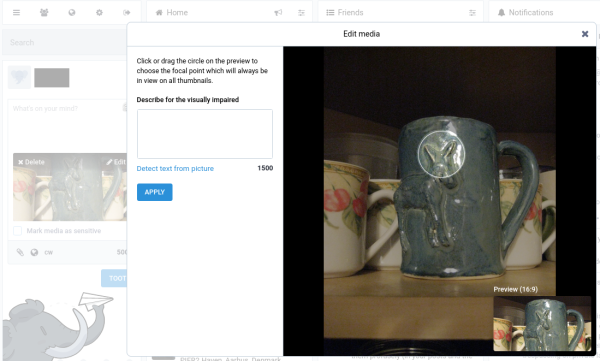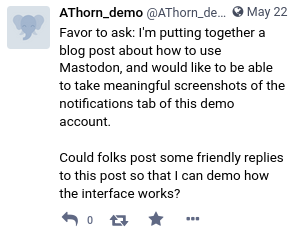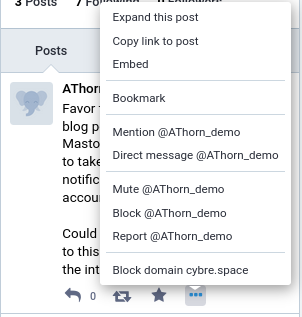finding people on Mastodon
Oct. 29th, 2022 09:39 amI've found that my experience of Mastodon is rather different from other social media I've tried. The people I follow on Mastodon are generally people I'd never met or heard of before. In that sense, it's almost the exact opposite of Facebook, which I think primarily provides a way of finding and connecting with people you already know.
The question, then, is how have I discovered people worth following. When I first joined cybre.space, my account was automatically subscribed to the admins of the server, and I think that's a pretty standard practice on Mastodon servers. That gives some exposure to content, and on some servers the admins have a standard practice of boosting introductory toots by new members, which can also help. All of the above relies on network effects, but there are a few other discovery tools on Mastodon as well.
Hashtags
I believe the primary discovery tool on Mastodon is hashtags. As a reaction against some of the more toxic dynamics on Twitter Mastodon intentionally does not provide tools to search the regular text of toots, but does provide a search interface for finding hashtags used in profiles and toots that your server knows about (users on that server, content on other servers that users on your own server have boosted or faved).
Hashtags are a pretty standard tool on Twitter and other social media. Any text string without spaces becomes a hash tag if you add the hash/number symbol ('#') in front. In Mastodon, when you do a search for a hashtag, you get back a list of tags that contain the search string, along with a bit of information on how much they are being used:
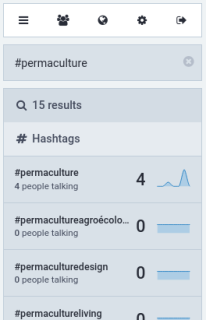
A low number of hits doesn't necessarily mean that there aren't people discussing a topic---not everyone uses hashtags, partly as a stylistic thing, and partly because many Mastodon users don't want to be found at all---but it can be a great starting point for seeing what is out there. Often you can use search to start to find discussion threads of potential interest, from which you can pivot to finding users with common interests and/or discover related tags to search for.
If you want people to be able to discover your account and posts, hashtags are a great way to help that to happen.
Databases and curated lists
There are also a number of people who have started to put together curated lists of users with particular interests. In general, Mastodon subcultures are big on privacy, so these lists are generally only of users who have requested to be included, people who are actively trying either to be found or to find people to connect with.
I've found a number of interesting users through Trunk: https://communitywiki.org/trunk/
People can use the form here https://communitywiki.org/trunk/request to request to have their accounts listed on Trunk, and specify what interests they want to be listed under. The Trunk admins then review the accounts which have made requests, screening for anything that looks like it might be a fake account or otherwise a bad actors.
There's also a directory of users, organized by the hashtags in their profiles, available here https://fediverse.info/explore/people. I haven't used this one as much, and it appears not to be curated.
At the other end of the spectrum, the user![[profile]](https://www.dreamwidth.org/img/silk/identity/user.png) fedifollows@mastodon.online posts about interesting accounts to follow, and has recently put together a curated list of users organized by interest (https://fedi.directory/).
fedifollows@mastodon.online posts about interesting accounts to follow, and has recently put together a curated list of users organized by interest (https://fedi.directory/).
Themed instances
Some Mastodons have subject matter themes or serve specific communities or subcultures. This can be another way of finding interesting people. The way this has worked for me is that, having discovered users through searches or by pivoting through social networks, I'll sometimes notice that a bunch of users with common interests or who are posting to the same threads on the same server. Often there's a clue in the server name for what the theme might be.
Sometimes when I've noticed a lot of users with common interests coming from the same server, I've followed up by visiting the server's main page and looking around. There's generally a "rules" or "about" page that gives information about server policies and the mission / intended audience. And there's generally a users or "explore" page where you can see a list of users on the server.
Here are some servers that I've discovered in this way, together with a short quote from their about page:
* https://scicomm.xyz/about/more - "This instance is aimed at scientists, science students, science communicators, future-scientists, or anyone with a rational mindset wanting to interact with each other and to help share your perspectives with the wider Fediverse."
* https://sunbeam.city/about/more - "Sunbeam City (or SBC for short) is a young cooperative of individuals whose mission is to promote what we believe to be the values of the solarpunk movement."
* https://scholar.social/about/more - "This is a queer-friendly general-purpose federated Mastodon instance. You may use it as a personal account, but the focus is on academics. Scholar Social has been described as 'The teacher's break room of the Fediverse.'"
Exploration examples
Back in May 2022, I made a post on my locked Dreamwidth, asking people for possible search terms / communities that folks I know might look for on Mastodon.
Here's some themes that came up in that discussion:
* Autism
* Brewing
* Fanfiction
* Fermentation
* Gardening (https://communitywiki.org/trunk/grab/Gardening)
* Homesteading
* Native plants
* Permaculture (https://communitywiki.org/trunk/grab/Permaculture)
* Polyamory / Consensual non-monogamy (https://communitywiki.org/trunk/grab/Consensual%20Non-Monogamy)
* Seed saving
* Tango
For topics that are listed on Trunk, I've added a link to the relevant Trunk user list.
Some of the above topics either 1) are emotionally charged and private (e.g. autism, polyamory), 2) cover technical information that I'm not sure I would be able to filter effectively (e.g. fermentation), or 3) just generally encompass too many subtopics (e.g. fanfiction). So for demonstration purposes I'm going to do a bit of poking around in the general areas of gardening/plants and tango.
Gardening
At the time I did the search for #gardening, 65 people were speaking about the topic. Right-clicking on the "#gardening" hashtag and selecting "open in new tab" gives me a full page view of the active discussions of gardening:
https://social.coop/tags/gardening

Many of the posts that came up are intro/bio posts, and I could click through to explore the users. This also gives me the option of discovering related hashtags that I might not have thought of, such as #harvest:
https://social.coop/tags/harvest

(I zoomed my browser out a bit to get more food images into the screenshot. It all looks delicious!)
Note that the above is the link to the #harvest tag on my own instance (social.coop). If I instead click on the tag link on the post where I saw it, I get a different collection of posts:
https://mstdn.social/tags/harvest
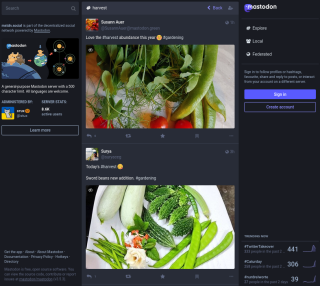
Tango
When I first tried searching for #tango on Mastodon, I was a little concerned that I'd have trouble finding actual content on Argentine tango as opposed to what I'm sure are gazillions of commercial products that have adopted the short, charismatic, punchy name "tango." (My parents even have a car that is "tango red.")
That turned out not to be a particular problem. On the other hand, most of the hits are (unsurprisingly) not in English:
https://social.coop/tags/tango
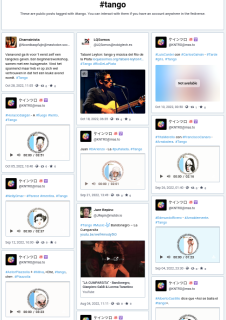
Still, if you scroll down a bit, there are a few people posting about tango in English, which could be a starting point for finding an English-speaking tango community on Mastodon.
There were also some other hashtags incorporating the text string "tango" that came up in my initial search:
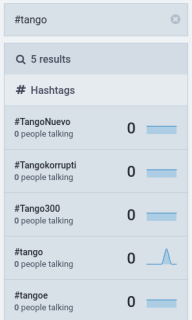
In past searches for other terms I've had some luck clicking around on similar hashtags, but in this case it didn't turn up much. I also tried doing some searches from other servers, but the content seemed about the same as from social.coop, so there might truly not be that much out there (at least in English).
Summary
I hope this post has given a decent overview of some tools for finding people on Mastodon. Some communities are better represented than others, but it's hard to know what's out there until you look. As I've remarked to a friend, Mastodon is full of iconoclasts. Lots of alternative lifestyles and alternative politics are well-represented. Some mainstream groups/activites are not as well represented (or at least are harder to find).
And of course, there are some things that are so mainstream as to be almost unavoidable...
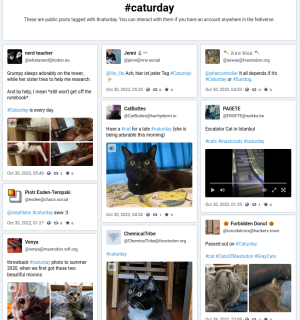
The question, then, is how have I discovered people worth following. When I first joined cybre.space, my account was automatically subscribed to the admins of the server, and I think that's a pretty standard practice on Mastodon servers. That gives some exposure to content, and on some servers the admins have a standard practice of boosting introductory toots by new members, which can also help. All of the above relies on network effects, but there are a few other discovery tools on Mastodon as well.
Hashtags
I believe the primary discovery tool on Mastodon is hashtags. As a reaction against some of the more toxic dynamics on Twitter Mastodon intentionally does not provide tools to search the regular text of toots, but does provide a search interface for finding hashtags used in profiles and toots that your server knows about (users on that server, content on other servers that users on your own server have boosted or faved).
Hashtags are a pretty standard tool on Twitter and other social media. Any text string without spaces becomes a hash tag if you add the hash/number symbol ('#') in front. In Mastodon, when you do a search for a hashtag, you get back a list of tags that contain the search string, along with a bit of information on how much they are being used:

A low number of hits doesn't necessarily mean that there aren't people discussing a topic---not everyone uses hashtags, partly as a stylistic thing, and partly because many Mastodon users don't want to be found at all---but it can be a great starting point for seeing what is out there. Often you can use search to start to find discussion threads of potential interest, from which you can pivot to finding users with common interests and/or discover related tags to search for.
If you want people to be able to discover your account and posts, hashtags are a great way to help that to happen.
Databases and curated lists
There are also a number of people who have started to put together curated lists of users with particular interests. In general, Mastodon subcultures are big on privacy, so these lists are generally only of users who have requested to be included, people who are actively trying either to be found or to find people to connect with.
I've found a number of interesting users through Trunk: https://communitywiki.org/trunk/
People can use the form here https://communitywiki.org/trunk/request to request to have their accounts listed on Trunk, and specify what interests they want to be listed under. The Trunk admins then review the accounts which have made requests, screening for anything that looks like it might be a fake account or otherwise a bad actors.
There's also a directory of users, organized by the hashtags in their profiles, available here https://fediverse.info/explore/people. I haven't used this one as much, and it appears not to be curated.
At the other end of the spectrum, the user
Themed instances
Some Mastodons have subject matter themes or serve specific communities or subcultures. This can be another way of finding interesting people. The way this has worked for me is that, having discovered users through searches or by pivoting through social networks, I'll sometimes notice that a bunch of users with common interests or who are posting to the same threads on the same server. Often there's a clue in the server name for what the theme might be.
Sometimes when I've noticed a lot of users with common interests coming from the same server, I've followed up by visiting the server's main page and looking around. There's generally a "rules" or "about" page that gives information about server policies and the mission / intended audience. And there's generally a users or "explore" page where you can see a list of users on the server.
Here are some servers that I've discovered in this way, together with a short quote from their about page:
* https://scicomm.xyz/about/more - "This instance is aimed at scientists, science students, science communicators, future-scientists, or anyone with a rational mindset wanting to interact with each other and to help share your perspectives with the wider Fediverse."
* https://sunbeam.city/about/more - "Sunbeam City (or SBC for short) is a young cooperative of individuals whose mission is to promote what we believe to be the values of the solarpunk movement."
* https://scholar.social/about/more - "This is a queer-friendly general-purpose federated Mastodon instance. You may use it as a personal account, but the focus is on academics. Scholar Social has been described as 'The teacher's break room of the Fediverse.'"
Exploration examples
Back in May 2022, I made a post on my locked Dreamwidth, asking people for possible search terms / communities that folks I know might look for on Mastodon.
Here's some themes that came up in that discussion:
* Autism
* Brewing
* Fanfiction
* Fermentation
* Gardening (https://communitywiki.org/trunk/grab/Gardening)
* Homesteading
* Native plants
* Permaculture (https://communitywiki.org/trunk/grab/Permaculture)
* Polyamory / Consensual non-monogamy (https://communitywiki.org/trunk/grab/Consensual%20Non-Monogamy)
* Seed saving
* Tango
For topics that are listed on Trunk, I've added a link to the relevant Trunk user list.
Some of the above topics either 1) are emotionally charged and private (e.g. autism, polyamory), 2) cover technical information that I'm not sure I would be able to filter effectively (e.g. fermentation), or 3) just generally encompass too many subtopics (e.g. fanfiction). So for demonstration purposes I'm going to do a bit of poking around in the general areas of gardening/plants and tango.
Gardening
At the time I did the search for #gardening, 65 people were speaking about the topic. Right-clicking on the "#gardening" hashtag and selecting "open in new tab" gives me a full page view of the active discussions of gardening:
https://social.coop/tags/gardening

Many of the posts that came up are intro/bio posts, and I could click through to explore the users. This also gives me the option of discovering related hashtags that I might not have thought of, such as #harvest:
https://social.coop/tags/harvest

(I zoomed my browser out a bit to get more food images into the screenshot. It all looks delicious!)
Note that the above is the link to the #harvest tag on my own instance (social.coop). If I instead click on the tag link on the post where I saw it, I get a different collection of posts:
https://mstdn.social/tags/harvest

Tango
When I first tried searching for #tango on Mastodon, I was a little concerned that I'd have trouble finding actual content on Argentine tango as opposed to what I'm sure are gazillions of commercial products that have adopted the short, charismatic, punchy name "tango." (My parents even have a car that is "tango red.")
That turned out not to be a particular problem. On the other hand, most of the hits are (unsurprisingly) not in English:
https://social.coop/tags/tango

Still, if you scroll down a bit, there are a few people posting about tango in English, which could be a starting point for finding an English-speaking tango community on Mastodon.
There were also some other hashtags incorporating the text string "tango" that came up in my initial search:

In past searches for other terms I've had some luck clicking around on similar hashtags, but in this case it didn't turn up much. I also tried doing some searches from other servers, but the content seemed about the same as from social.coop, so there might truly not be that much out there (at least in English).
Summary
I hope this post has given a decent overview of some tools for finding people on Mastodon. Some communities are better represented than others, but it's hard to know what's out there until you look. As I've remarked to a friend, Mastodon is full of iconoclasts. Lots of alternative lifestyles and alternative politics are well-represented. Some mainstream groups/activites are not as well represented (or at least are harder to find).
And of course, there are some things that are so mainstream as to be almost unavoidable...


